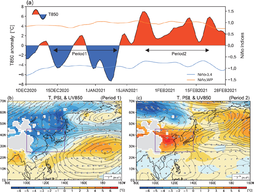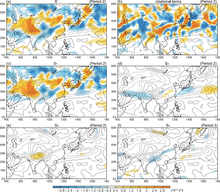・The turnabout of air temperature anomalies over East Asia between the first and second halves of winter 2020/21 was examined from a teleconnection perspective with regionally different convective heating anomalies over the Indo-western Pacific sector.
・To investigate the differences in the formation and maintenance mechanisms of the two teleconnection patterns of SAJ pattern and WP pattern, we extracted the patterns that occurred in the past from the atmospheric data of the past 47 years, and performed vorticity budget analysis and numerical model experiments.
・By examining the transition between cold and warm conditions during the winter in such detail, this research is expected to contribute to improving the accuracy of seasonal forecasts.
Abstract
In the first half of winter 2020/21, the air temperature over East Asia was lower than normal, accompanied by a pair of anticyclonic and cyclonic anomalies in the upper troposphere southeast of the Tibetan Plateau and north of Japan, respectively. This dipole pattern is newly referred to as the Southeast Asia–Japan (SAJ) pattern in this study, indicating the propagation of Rossby waves caused by enhanced tropical convection over the eastern Indian Ocean toward the South China Sea. In the second half of winter 2020/21, the enhanced convection shifted eastward to the Philippine Sea. The subsequent anticyclonic anomaly changed its position to the south of Japan, which was similar to the western Pacific (WP)-like teleconnection pattern, causing warmer conditions over East Asia. The composite analysis indicated that the anomalous anticyclone over the southeastern Tibetan Plateau corresponding to the SAJ pattern emerged simultaneously with intensification of convection over the South China Sea. Half of the cases of the WP-like pattern have been accompanied by enhanced convection over the Philippine Sea. The different circulation patterns were reproduced by prescribing the heat source over the South China Sea and Philippine Sea to the linear baroclinic model. Moreover, the vorticity budget analysis suggested that the presence of upper-tropospheric convergence of winds to the southeast of the Tibetan Plateau seen in the climatology is conceivable for the in situ localized anomalous circulation constituting the SAJ pattern due to vortex stretching effects.
Benefit
In this study, it was revealed that the teleconnection pattern (PJ pattern) that brings intense heat to Japan and the teleconnection pattern (SAJ pattern) that brings cold winters, while having similar excitation sources, have different dynamical structures and impacts on climate.
Market Application
We plan to closely examine the relationship between the SAJ pattern and MJO revealed in this analysis, and utilize it to improve forecast accuracy.
Publications
https://www.jstage.jst.go.jp/article/jmsj/101/1/101_2023-002/_html/-char/en



